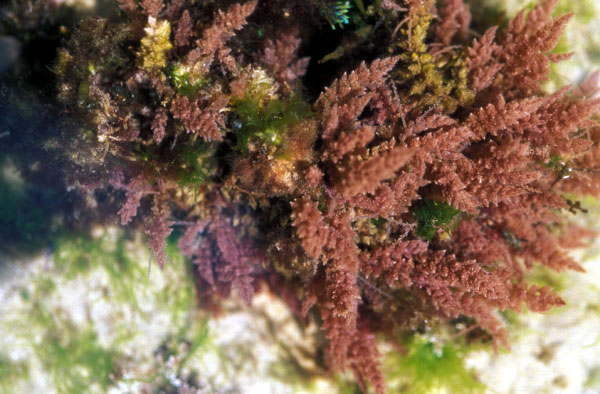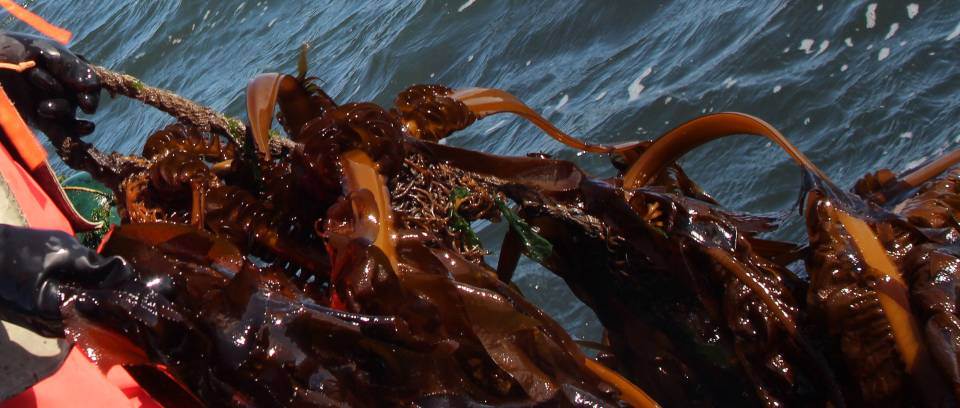Gracilaria edulis was successfully cultured by the reproductive propagation method in the Gulf of Mannar, during November-March 1991-'92 and 1992-'93. Healthy young plants were harvested twice during 1993 within 135 days of culture period. Nursery rearing for a brief period was done for the carpospores to grow upto the germling stage in enriched seawater before transplanting to the sea. The plant attained maximum length of 34 cm (average length 21.55 ± 7.30 cm) and a fresh weight of 12.430 kg on harvest. The quantitative estimation of agar showed an average yield of 14.57 % with gelling temperature of 48.8°C, melting temperature of 85.0°C and gel strength of 98.6 g/cm^.
Digital library
-
-
Protoplast is an important tool for parasexual modification of genetic content of plant cells (Vasil and Vasil, 1980). Production of algal protoplasts and their fusion are relatively new fields and lag far behind that of terrestrial plants (Berliner 1981, 1983; Cheney et af., 1986). To date, protoplasts have been isolated from several algae, most of which are blue green algae and green algae (Adamich and Hemmingsen, 1980). Protoplasts have been obtained from some marine brown algae (Kloareg and Quantrano, 1987).
-
The aim of the present study was concentrates on different group of seaweeds like green (Ulva reticulata, Enteromorpha compressa, Cladophora glomerata, Halimeda macroloba and Halimeda tuna) brown (Dictyota dichotoma, Turbinaria ornata and Padina pavonica) and red (Gelidiella acerosa, Gracilaria crassa and Hypnea musciformis) were collected from Vedalai coastal waters, Southeast coast of India for analyzed proximate composition. The protein content was recorded maximum in G. acerosa and minimum in D. dichotoma; carbohydrate level was observed in T. ornata and minimum in P. pavonica. The lipid content was acquired higher level in H. tuna and minimum in H. macroloba.
-
Gelidialian red algae, that contain rhizoidal filaments, except the family Gelidiellaceae were processed to make bleached pulps, which can be used as raw materials for papermaking. Red algae consist of rhizoidal filaments, cortical cells usually reddish in color, and medullary cells filled with mucilaginous carbohy- drates. Red algae pulp consists of mostly rhizoidal filaments.
Red algae pulp of high brightness can be produced by extracting mucilaginous carbohydrates after heating the algae in an aqueous medium and subsequently treating the extracted with bleaching chemicals. In this study, we prepared paper samples from bleached pulps obtained from two red algae species (Gelidium amansii and Gelidium corneum) and compared their properties to those of bleached wood chemical pulps.
-
Norwegian research scientists from the SINTEF are convinced that kelp may share many of the applications of soy and oil in the fish farming industry. “We can break seaweed down into their basic constituents and recombine them to make useful products,” said researcher Silje Forbord at SINTEF. “We can use seaweed to make clothes, furniture materials, food packaging, drinking straws and biodegradable bottles,” Forbord said.
The team has been active in the forefront of a research project called MACROSEA, which is providing new insights into the potential of seaweed farming in Norway. The project has also succeeded in developing innovative solutions that will assist in industrializing the Norwegian seaweed sector.
-
There is an increasing interest in the use of Saccharina latissima (sugar kelp) as food, but the high iodine content in raw sugar kelp limits the daily recommended intake to relatively low levels. Processing strategies for iodine reduction are therefore needed. Boiling may reduce the iodine content effectively, but not predictably, since reductions from 38–94% have been reported. Thus, more information on which factors affect the reduction of iodine are needed. In this paper, sugar kelp cultivated at different depths were rinsed and boiled, to assess the effect of cultivation depth on the removal efficacy of potentially toxic elements (PTEs), especially iodine, cadmium, and arsenic, during processing. Raw kelp cultivated at 9 m contained significantly more iodine than kelp cultivated at 1 m, but the difference disappeared after processing. Furthermore, the content of cadmium and arsenic was not significantly affected by cultivation depth. The average reduction during rinsing and boiling was 85% for iodine and 43% for arsenic, but no significant amount of cadmium, lead, or mercury was removed. Cultivation depths determined the relative effect of processing on the iodine content, with a higher reduction for kelp cultivated at 9 m (87%) compared to 1 m (82%). When not taken into consideration, cultivation depth could mask small reductions in iodine content during rinsing or washing. Furthermore, since the final content of PTEs was not dependent on the cultivation depth, the type and extent of processing determines whether cultivation depth should be considered as a factor in cultivation infrastructure design and implementation, or alternatively, in product segmentation.
-
The integration of bioremediation systems is one of the most promising techniques to mitigate the environmental impact of aquaculture effluents. Also, it allows nutrient recycling, production diversification, and the creation of high-value by-products. In marine aquaculture, where the implementation of salt-tolerant extractive species is essential, halophyte plants have demonstrated to be optimal candidates for bioremediation of saline aquaculture wastewater.
This study aimed to evaluate for the first time the efficiency of Sarcocornia neei (Lag.), a halophyte plant with high adaptability, salinity tolerance and growth potential when irrigated with seawater, in removing nutrients from marine fish aquaculture wastewater and artificial effluents. Two experiments were carried out. In the first one, the growth rate, removal of inorganic nutrients, and accumulation of organic compounds in deep-water hydroponics and sand-substrate systems were evaluated in artificial effluents with different nitrogen and phosphate loads during 70 days. In the second, due to the better performance achieved by S. neei in deep-water systems, its nitrogen removal efficiency and productivity rates were evaluated in deep-water aquaponics with marine aquaculture wastewater and artificial effluents at higher nitrogen loads during 61 days.
The highest productivity rates achieved by S. neei (14.41 ± 0.78 kg m−2) were obtained in deep-water culture units, reaching 100% plant survival, suggesting that this species is more suitable for its implementation in this type of system. Significant total ammonia nitrogen removal rates were obtained by the plants, achieving a maximum in sand-substrate systems (0.68 ± 0.41 g m−2 day−1). The results of nitrate removal rates obtained by S. neei (11.25 ± 31.38 g m−2 day−1) make this species an ideal potential candidate for the removal of this compound present in marine RAS effluents. Accumulation of organic compounds was corroborated by obtaining a significant increase (p < 0.05) in organic N (31.2 ± 0.1 mg g dry weight−1) and organic P (4.0 ± 0.6 mg g dry weight−1) content in plant biomass at the end of the trials.
These results indicated that S. neei is a good candidate for its use as a biofilter for marine aquaculture wastewater. Further investigations should be done to analyze possible influences on growth rates and nutrient removal efficiency by adding essential micronutrients, adjusting effluent salinity, and implementing different plant densities. Also, further studies could be interesting to determine the feasibility of long-term integration of a bioremediation system with S. neei associated with marine aquaculture effluents, approaching its application to industrial-scale production systems.
-
Young plants of S. ilicifolium and S. myricosystum appear in April and May and reach the maximum size in September or October. Alginic acid yield varies with the seasonal growth behaviour of these alginophytes. with maximum yield in July or August. Alginic acid content varies from 22.3 to 30.8% in S. ilieifolium and from 15.9 to 34.5% in S. myriocyslum. Mannitol content ranges from 2 to 5 and 1.3 to 5% in S. jlicifolium and S. myriocysmm respectively. The suitable harv.esting period for getting the maximum yidd of algin ic acid appears to be between July and September.
-
Seasonal variation in growth and biochemical constituents such as protein, carbohydrate and lipid in Hypnea valentiae, Acanthophora spicifera, Laurencia papillosa, Enteromorpha compressa, Ulva lactuca and Caulerpa recemosa were observed for one year from April, 1995 to March 1996. Carrageenan content was estimated from H. valentiae, A. spicifera and L. papillosa. In general, peak growth and biomass of these algae occurred during the period June -August and January - March. The maximum values in these algae varied from 12.5 to 13.2% for protein, 13.0 to 13.3% for carbohydrate and 10.3 to 12.0% for lipid. The yield of phycocolloid recorded 11.3%, 6.0% and 8.1% in H. valentiae, A. spicifera and L. papillosa respectively.
-
Essential micro-nutrients such as manganese, copper, lead and zinc were analysed in three species of Gracilaria for 12 months from August 1994 to July, 1995. Comparative data on the interspecific variation of essential micro-nutrients have been explained. Seasonal variation of the trace element within the species were also analysed. Zinc content was found to be maximum in all the species of Gracilaria. In general, the decreasing trend of essential micro-nutrients was Zn>Pb>Cu>Mn. Manganese and copper content were found to be comparatively higher in G. edulis whereas lead dominated in G. crassa.





